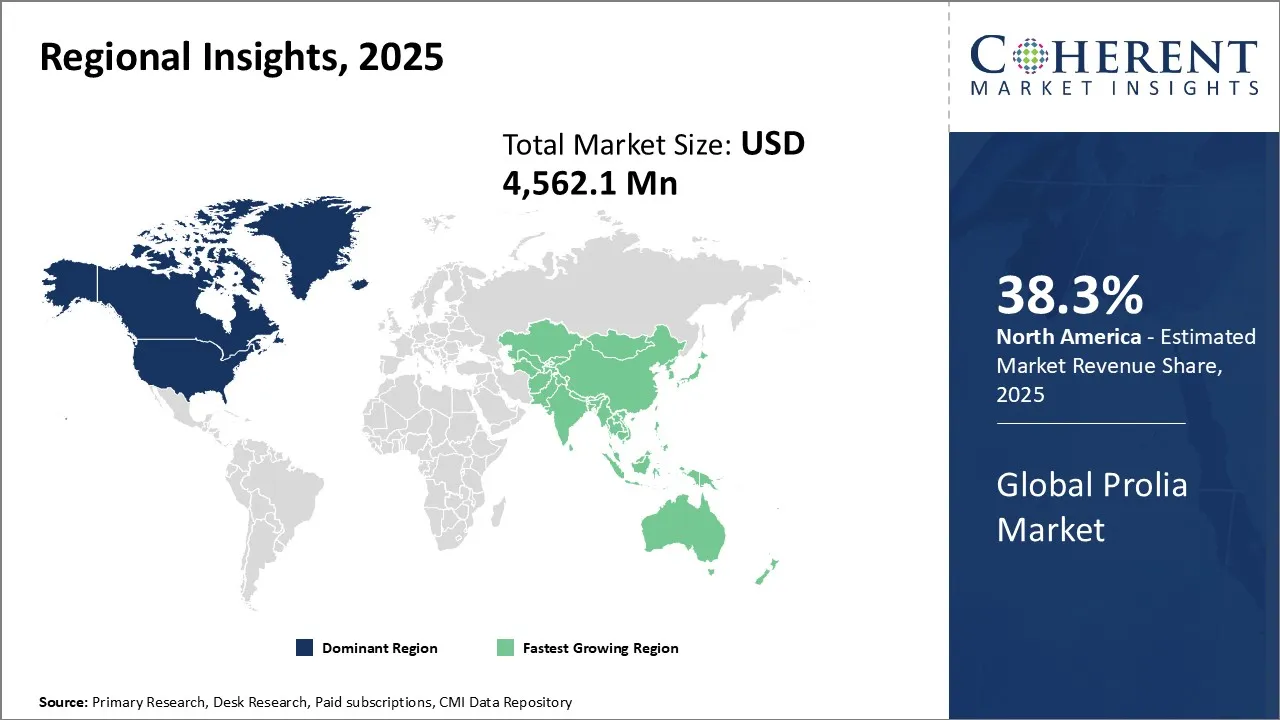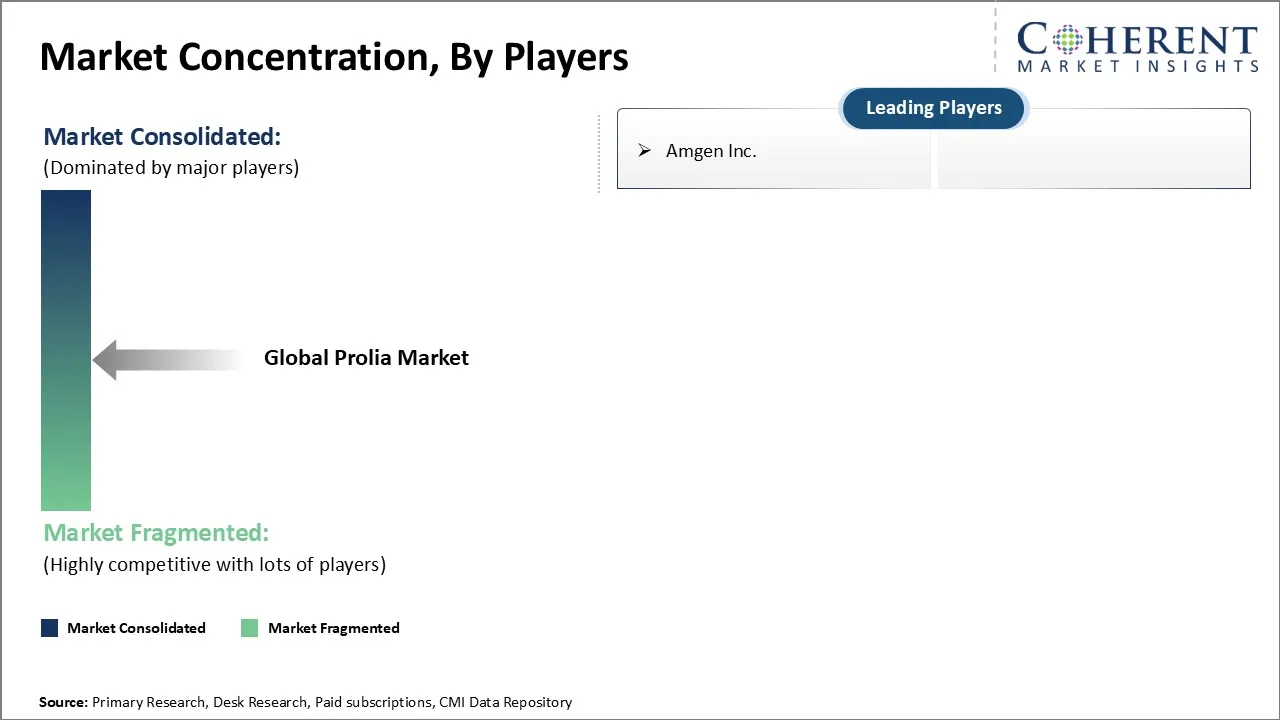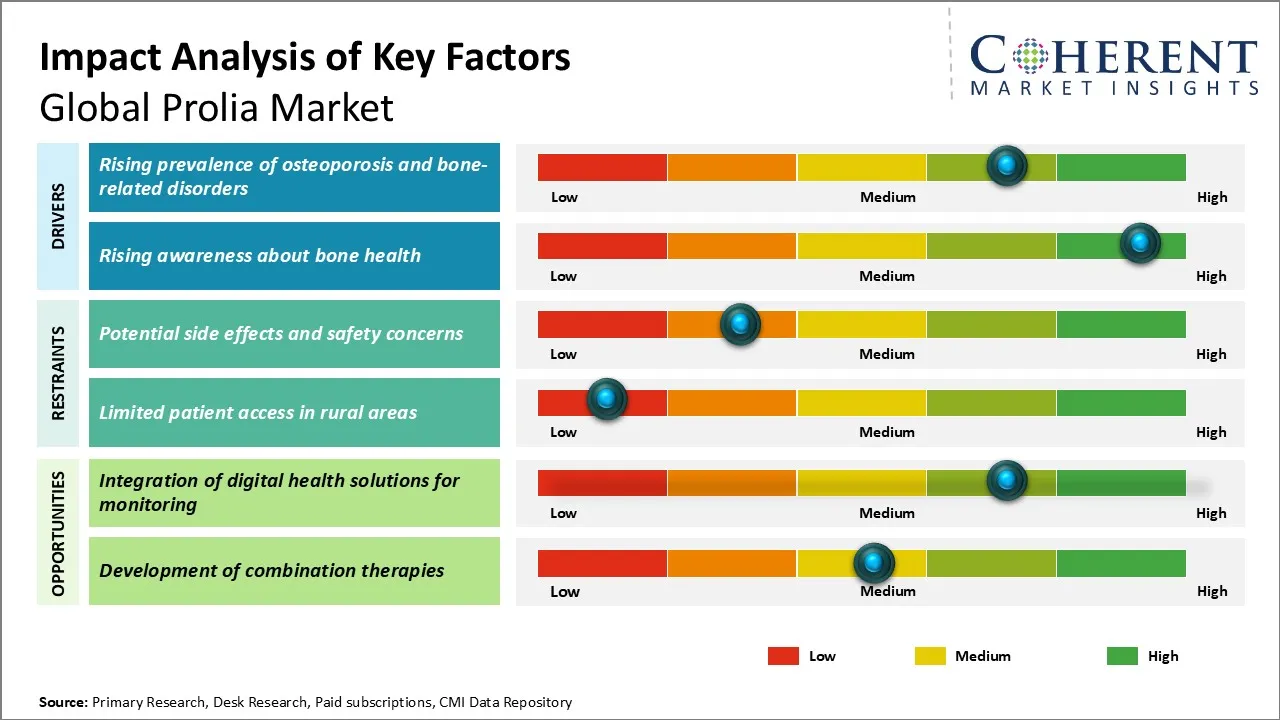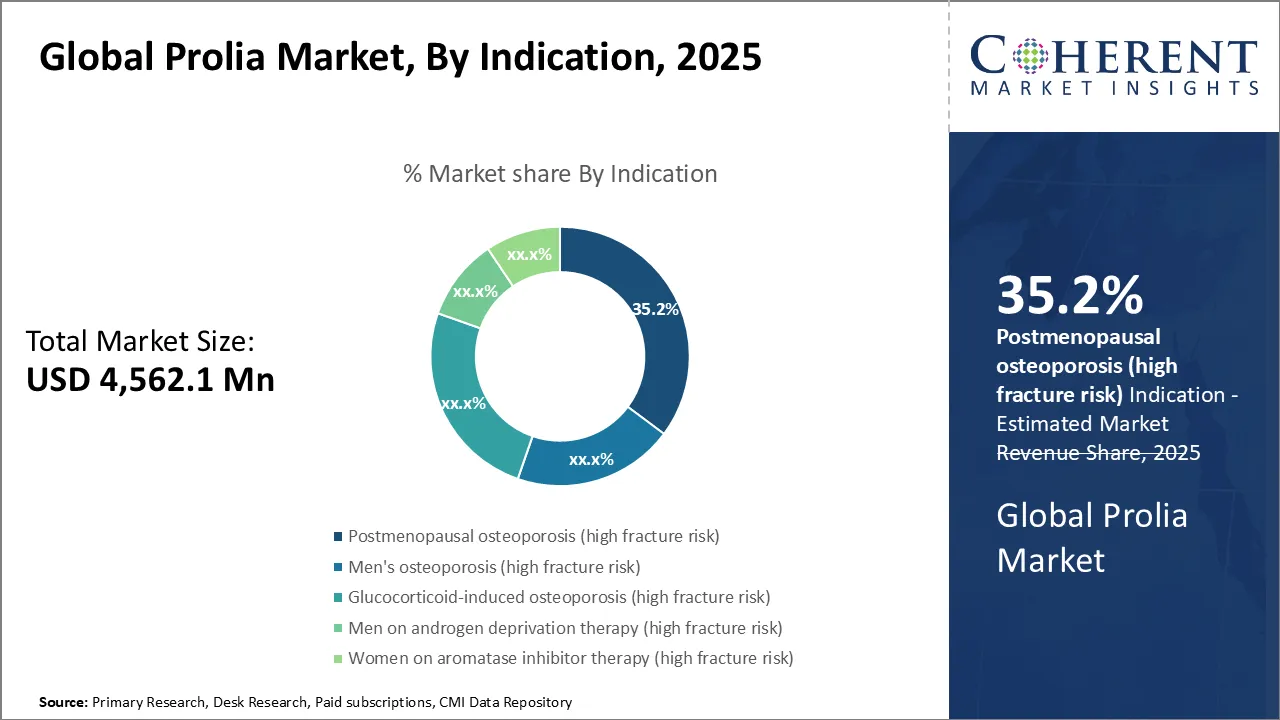Global Prolia Market Size and Forecast – 2025 to 2032
The Global Prolia Market is estimated to be valued at USD 4,562.1 Mn in 2025 and is expected to reach USD 5,703.2 Mn by 2032, exhibiting a compound annual growth rate (CAGR) of 3.2% from 2025 to 2032. This steady growth reflects increasing adoption and awareness of Prolia as a treatment option for osteoporosis and related bone disorders, supported by rising prevalence rates and expanding healthcare infrastructure worldwide.
Key Takeaways of The Global Prolia Market
- In terms of indication, Postmenopausal osteoporosis (high fracture risk) segment is expected to hold the largest share of 35. 2% in 2025.
- By age group, the adult segment is expected to dominate the global Prolia market with a share of 32. 5% in 2025.
- By gender, the female segment is expected to represent the largest portion of the global Prolia market, making up 85. 2% in 2025.
- North America is expected to lead the market, holding a share of 38.3% in 2025. Asia Pacific is anticipated to be the fastest-growing region, with a market share of 27.2% in 2025.
Market Overview
The market trend for Prolia is characterized by a growing focus on personalized medicine and innovative drug delivery methods, enhancing patient compliance and treatment outcomes. Additionally, the increasing geriatric population and the prevalence of osteoporosis are driving demand. Advancements in biotechnology and ongoing clinical trials aimed at expanding indications for Prolia further contribute to market dynamism. Furthermore, collaborations between pharmaceutical companies and healthcare providers are facilitating broader market penetration and accessibility.
Current Events and Its Impact
|
Current Events |
Description and its impact |
|
Patent Settlement with Sandoz |
|
|
Integration of Digital Health and Telemedicine |
|
Uncover macros and micros vetted on 75+ parameters: Get instant access to report
Prolia Market Insights, By Indication - Postmenopausal Osteoporosis Dominates in Prolia Usage Driven by High Fracture Risk and Hormonal Changes
In terms of indication, postmenopausal osteoporosis (high fracture risk) is expected to hold the largest share of the global Prolia market with 35.2% in 2025, predominantly due to the physiological and hormonal shifts women experience following menopause. The marked decline in estrogen levels during this phase is a principal driver leading to accelerated bone resorption and reduced bone mineral density, thereby significantly heightening susceptibility to fractures. This biological vulnerability positions postmenopausal women as the primary beneficiaries of Prolia, which functions as a RANKL inhibitor to effectively mitigate estrogen-deficiency induced bone loss.
For instance, according to a study by the National Library of Medicine, in January 2023, a study conducted in Northern India on postmenopausal women revealed that 82.2% of participants had osteoporotic fractures, with 37.5% diagnosed with osteoporosis and 44.7% with osteopenia. The research, which included 539 women aged 50–80, identified key risk factors such as increased parity, history of abortions, family history of osteoporosis, and previous fragility fractures. The findings highlight a significant prevalence of osteoporosis and osteopenia among postmenopausal women in India, stressing the urgent need for focused efforts to address this growing health issue. The study also underscores menopause as a major contributor to bone loss, especially in the first few years after its onset.
Additionally, many patients in this category often present co-morbidities and contraindications that limit the use of alternative osteoporosis treatments, such as bisphosphonates, further amplifying Prolia’s therapeutic appeal.
Prolia Market Insights, By Age Group - Pediatric Segment Leads Due to Focused Therapeutic Needs and Emerging Bone Health Awareness
The adult segment is expected to dominate the global Prolia market, contributing significantly to its market share with 32.5% in 2025. As of 2025, this segment is driven by a rising incidence of osteoporosis and related bone disorders in adults, particularly those at high risk for fractures. Additionally, Prolia’s ability to prevent skeletal-related events and improve bone mass in adult patients receiving treatments such as aromatase inhibitors for breast cancer further boosts its demand in this demographic.
For instance, in April 2023, a clinical trial at the National Institutes of Health (NIH) found that denosumab, a medication used to treat bone disorders, significantly reduced abnormal bone turnover in adults with fibrous dysplasia, a rare disease causing weak and misshapen bones.
Furthermore, the adult segment is influenced by increasing awareness about bone health and preventive care, which has prompted more adults, especially postmenopausal women and men, to seek medical attention for conditions like osteoporosis. Prolia’s ability to reduce the risk of fractures, particularly in patients with high fracture risk, continues to make it a preferred choice among healthcare providers. As the adult population ages and health issues such as bone degeneration become more prominent, Prolia’s efficacy in increasing bone mass and preventing fractures ensures its continued dominance in this segment.
Prolia Market Insights, By Gender - Female Segment Leads Due to Rising Awareness and Targeted Treatment of Male Osteoporosis
In terms of gender, the female segment is expected to account for the highest share of the global Prolia market with 85.2% in 2025. Osteoporosis is more prevalent in women, particularly after menopause treatment, due to the drop in estrogen levels, which weakens bone density. As a result, Prolia has become a key treatment option for this demographic, helping to prevent fractures and reduce the risks associated with bone loss in postmenopausal women.
The widespread use of Prolia among women is driven by the high incidence of osteoporosis in this population, making them the dominant segment in the market. Given that osteoporosis-related fractures can severely impact quality of life, Prolia plays a crucial role in the prevention and management of this condition, leading to its dominant position in the global market for osteoporosis treatments.
In October 2021, according to World Journal of Men's Health, a recent observational study conducted at an outpatient service for osteoporosis diagnosis revealed significant gender disparities in osteoporosis screening and outcomes. Out of 3,752 patients, only 5.4% were men, with women making up the majority (94.5%). The study found that women had lower bone mineral density (BMD) and higher bone remodeling markers compared to men, but men had a significantly higher prevalence of fractures (50% vs. 31%). Interestingly, men were more likely to have secondary osteoporosis (66.67% vs. 20.83%) and a higher risk of hip fractures.
Pricing Analysis of Global Prolia Market
- The global pricing for Prolia (denosumab) varies significantly across countries, reflecting differences in healthcare systems, regulatory frameworks, and market conditions. In the United States, Prolia's out-of-pocket cost for a 60 mg injection is around USD 1,875.4, which is the highest among the listed countries. In contrast, countries like India, Japan, and South Africa see much lower prices, with India priced at USD 258.5, Japan at USD 210, and South Africa at USD 224. The pricing trend across various European countries, including the U.K., Germany, and France, ranges from USD 307 to USD 518.2. These disparities in pricing reflect the influence of factors such as local healthcare infrastructure, purchasing power, insurance coverage, and government pricing policies.
- Looking ahead, the pricing of Prolia is expected to change significantly by 2032, with price increases projected in countries like the United States (35-50%), driven by factors such as patent exclusivity and market demand. On the other hand, price reductions are anticipated in countries with increasing biosimilar adoption and rising market competition. For example, countries like India, Japan, and the U.K. may experience price drops of 20-30% as biosimilars enter the market, offering more affordable alternatives and stimulating price competition. These trends suggest that Prolia’s pricing will continue to be influenced by factors like the introduction of biosimilars, manufacturing costs, and regulatory changes, ultimately making it more accessible in emerging markets while maintaining higher costs in regions with limited competition.
Regional Insights

To learn more about this report, Download Free Sample
North America Prolia Market Analysis and Trends
North America Prolia market is expected to hold a dominant position largely with a share of 38.3% in 2025 due to the well-established healthcare infrastructure, high incidence of osteoporosis and bone-related ailments, and strong presence of leading pharmaceutical companies. The region benefits from robust reimbursement frameworks and proactive government policies supporting osteoporosis management and awareness programs.
The U.S., a key market within this region, facilitates swift product approvals and widespread insurance coverage, further strengthening Prolia's market penetration. Additionally, established collaborations between biotech firms and health institutions streamline R&D and patient access. Notable companies such as Amgen, which originally developed Prolia, have a significant operational and commercial foothold in North America, driving innovation and market expansion.
Asia Pacific Prolia Market Analysis and Trends
The Asia Pacific region is expected to exhibit the fastest growth in the Prolia market with a share of 27.2% in 2025, fueled by increasing healthcare spending, rising awareness of osteoporosis, and expanding elderly demographics. Key countries like China, Japan, and India show growing demand due to rapid urbanization, lifestyle changes, and improved diagnosis rates. Government initiatives aimed at enhancing healthcare infrastructure and promoting chronic disease management also contribute to this growth trajectory.
For instance, according to a study by Commonwealth of Australia in April 2023, a USD 5.7 million research grant has been awarded to four projects aimed at improving chronic disease prevention in the Asia-Pacific region. Funded by the National Health and Medical Research Council through the Global Alliance for Chronic Diseases, these projects focus on fostering research partnerships and capacity building. One key project evaluates the Health Promoting Schools program in Fiji to enhance student health, while others aim to reduce heart disease and diabetes in India, build resilience to NCDs in resource-limited areas, and improve primary healthcare in Nepal, particularly for antenatal and postnatal care.
Trade liberalization and favorable regulatory reforms have attracted multinational pharmaceutical companies, enabling greater market access. Companies, such as Amgen, along with regional players, are leveraging partnerships and localization strategies to capture market share in this burgeoning region.
Prolia Market Outlook for Key Countries
U.S. Prolia Market Trends
The U.S. remains a powerhouse for the Prolia market due to its advanced healthcare facilities, extensive insurance coverage, and significant patient population requiring osteoporosis treatment. for example, Prolia is widely covered by most Medicare and commercial insurance plans, making it more accessible to patients. The list price for Prolia is USD 1,875.43 per injection, administered every six months, though actual out-of-pocket costs vary depending on insurance coverage and additional fees for doctor administration or pharmacy charges.
Most patients do not pay the full list price. For those on Medicare, commercial insurance, or without insurance, there are resources available to help navigate coverage options. Amgen’s strong marketing and distribution channels, along with ongoing clinical studies, reinforce the product’s positioning. The U.S. regulatory environment facilitates rapid approval pathways, enabling timely access for patients. Additionally, collaborations with healthcare providers and advocacy groups contribute to heightened disease awareness and sustained demand.
Japan Prolia Market Trends
Japan’s rising numbers of osteoporosis patients makes it a critical market for Prolia, requiring effective treatment options. The government’s commitment to addressing age-related diseases and implementation of supportive reimbursement policies underpin steady market growth. Local pharmaceutical partnerships and market adaptations by Amgen allow effective navigation through regulatory requirements and cultural nuances, ensuring robust uptake. Japan’s advanced healthcare system supports better diagnosis and adherence, positively impacting treatment outcomes and sales.
For instance, in November 2024, according to the Journal of Orthopaedic Science, osteoporosis is a significant health concern in Japan, with an estimated 12.8 million people affected. A study revealed that while only 191 osteoporosis-related deaths were officially recorded in 2021, the actual number may be much higher. By reviewing individual death certificates, it was estimated that approximately 3,627 deaths could be attributed to osteoporosis. This suggests that the mortality rate from osteoporosis in Japan is likely underreported, highlighting the need for better recognition and reporting of osteoporosis-related deaths.
China Prolia Market Trends
The Prolia market in China is influenced by the growing prevalence of osteoporosis, particularly among postmenopausal women. Osteoporosis is a significant public health issue in China, with studies indicating a higher prevalence in women, especially those aged 50 and older. Factors such as urbanization and changing lifestyles contribute to the rise in bone health concerns. Prolia is gaining traction as a key treatment option due to its proven efficacy in reducing fractures and improving bone density. As awareness of osteoporosis grows, the demand for effective treatments like Prolia is expected to increase, driving market trends in China.
For instance, in January 2025, a systematic review study by National Library of Medicine on the prevalence of osteoporosis among Chinese adults found that the condition is more common in females and increases with age. The study included 129 articles, showing that osteoporosis prevalence was higher in females and varied by skeletal site, with the highest prevalence at the ward’s triangle. The WHO diagnostic criteria revealed a prevalence of 13.54%, while the Chinese criteria showed a significantly higher 29.49%. The total number of affected adults in 2020 was estimated to be 145.86 million (WHO) and 317.54 million (CHN). The study identified regional differences, with Northeast China having the highest prevalence.
Germany Prolia Market Trends
Germany benefits from a mature healthcare ecosystem with universal health coverage, ensuring patient access to advanced osteoporosis treatments. The country’s strong pharmaceutical industry presence, combined with stringent regulatory standards, fosters high-quality market offerings. Amgen and other biotech companies leverage Germany as a strategic hub for European operations. Public and private insurance systems offer reimbursement for Prolia, enhancing affordability and uptake among patients. Ongoing research initiatives further solidify Germany’s prominent position within the European Prolia market.
Market Players, Key Developments, and Competitive Intelligence

To learn more about this report, Download Free Sample
Key Developments
- In May 2023, Amgen, a global biotechnology company, announced new data from a real-world study of nearly 500,000 postmenopausal women with osteoporosis, showing that Prolia (denosumab) significantly reduced fracture risk compared to alendronate. Prolia was associated with greater reductions in fracture risk over time. The study, presented at the World Congress on Osteoporosis in May 2023, demonstrated that longer treatment with Prolia led to even more significant risk reductions. This data underscores Prolia's potential to reduce life-altering fractures in women at high risk.
- In April 2024, Shanghai Henlius Biotech, Inc. and Organon announced that the Phase 3 comparative clinical study of HLX14, a biosimilar to Prolia and Xgeva (denosumab), successfully met its primary endpoints. The study, aimed at evaluating the efficacy, safety, tolerability, and immunogenicity of HLX14 compared to EU-sourced reference denosumab in postmenopausal women with osteoporosis at high fracture risk, showed positive results.
Market Report Scope
Prolia Market Report Coverage
| Report Coverage | Details | ||
|---|---|---|---|
| Base Year: | 2024 | Market Size in 2025: | USD 4,562.1 Mn |
| Historical Data for: | 2020 To 2024 | Forecast Period: | 2025 To 2032 |
| Forecast Period 2025 to 2032 CAGR: | 3.2% | 2032 Value Projection: | USD USD 5,703.2 Mn |
| Geographies covered: |
|
||
| Segments covered: |
|
||
| Companies covered: |
Amgen Inc. |
||
| Growth Drivers: |
|
||
| Restraints & Challenges: |
|
||
Uncover macros and micros vetted on 75+ parameters: Get instant access to report
Prolia Market Dynamics

To learn more about this report, Download Free Sample
Prolia Market Driver - Rising Prevalence of Osteoporosis and Bone-related Disorders
The growing incidence of osteoporosis and other bone-related disorders globally is a significant driver fueling demand for Prolia. As populations age, particularly in developed and emerging economies, the likelihood of bone density loss and consequent fractures has escalated, prompting an increased need for effective therapeutic options. Osteoporosis predominantly affects postmenopausal women due to hormonal changes that accelerate bone degradation, while older men are also experiencing rising rates of bone fragility. This demographic shift, coupled with sedentary lifestyles, nutritional deficiencies, and the prevalence of chronic illnesses such as rheumatoid arthritis, contributes to the heightened risk of bone fractures and osteoporosis-related complications. Prolia, with its mechanism of action targeting bone resorption by inhibiting RANKL, addresses the critical medical demand for preventing fractures and improving bone strength.
For instance, according to Journal of Orthopaedic Surgery and Research, in October 2021, a comprehensive systematic review and meta-analysis on the global prevalence of osteoporosis, conducted by Salari et al. (2021), found that the worldwide prevalence of osteoporosis is 18.3%. The study included 86 studies with a sample size of over 103 million people aged 15–105 years. The prevalence was higher in women (23.1%) compared to men (11.7%). Africa reported the highest prevalence at 39.5%. The findings highlight the significant medical, economic, and social burden of osteoporosis, emphasizing the need for informed policymaking and improved treatment facilities to reduce fracture risks and enhance overall osteoporosis management.
Prolia Market Opportunity - Integration of Digital Health Solutions for Monitoring
The integration of digital health solutions presents a significant opportunity to enhance the Global Prolia market, particularly in improving patient adherence, monitoring treatment efficacy, and streamlining healthcare provider interactions. Prolia, primarily used for osteoporosis and bone loss treatment, requires strict adherence to dosing schedules and ongoing monitoring of patient bone density and response to therapy. Digital health technologies, such as mobile health apps, wearable devices, and remote patient monitoring platforms, can facilitate real-time tracking of patient compliance and clinical outcomes.
These tools enable healthcare providers to receive timely data on patients' health status, medication adherence, and potential side effects, allowing for personalized interventions and adjustments to treatment plans. Moreover, digital solutions can educate patients through tailored reminders and insights, addressing one of the major challenges in chronic disease management medication non-adherence. Integrating digital health with Prolia therapy not only provides actionable insights to clinicians but also empowers patients to actively engage in their treatment journey, ultimately improving health outcomes.
For instance, in March 2025, Osteoboost Health, Inc., a company focused on innovative bone health solutions, has been awarded U.S. Patent No. 12,232,993 for Osteoboost, a wearable device designed to treat osteopenia and improve bone health through targeted vibration therapy. This marks the 6th patent for the device, which is the first U.S. FDA-cleared non-drug treatment for bone density improvement. The device uses vibration to stimulate bone growth, and includes accelerometers for monitoring treatment effectiveness and compliance.
Analyst Opinion (Expert Opinion)
- The global Prolia market is experiencing substantial growth, driven by key factors such as technological advancements in drug delivery systems, increasing regulatory support for bone health treatments, and rising demand for effective therapies addressing osteoporosis and bone-related disorders. With a growing geriatric population and an increasing focus on preventative healthcare, Prolia, a leading bone-forming therapy, continues to gain traction. Emerging opportunities in the market include expanding applications of Prolia in treating conditions like bone metastases, as well as potential for broader adoption in underpenetrated markets, particularly in Asia-Pacific and Latin America. However, challenges remain, such as high treatment costs and regulatory hurdles in certain regions, which could hinder widespread accessibility.
- Recent conferences such as the International Osteoporosis Foundation World Congress and the American Society for Bone and Mineral Research (ASBMR) Annual Meeting have played a pivotal role in advancing knowledge within the Prolia space. These events provide valuable platforms for policy discussions, knowledge-sharing on innovative treatments, and showcasing technological advancements in drug delivery methods. Real-world initiatives like government-backed programs to subsidize osteoporosis treatments in Europe and North America, alongside collaborative efforts between pharmaceutical companies and healthcare providers, are expected to positively influence market growth. Additionally, ongoing clinical trials aimed at expanding the therapeutic indications of Prolia will likely strengthen its market position in the coming years.
Market Segmentation
- Indication Insights (Revenue, USD Mn, 2020 - 2032)
- Postmenopausal osteoporosis (high fracture risk)
- Men’s osteoporosis (high fracture risk)
- Glucocorticoid-induced osteoporosis (high fracture risk)
- Men on androgen deprivation therapy (high fracture risk)
- Women on aromatase inhibitor therapy (high fracture risk)
- Age Group Insights (Revenue, USD Mn, 2020 - 2032)
- Pediatric
- Adult
- Geriatric
- Gender Insights (Revenue, USD Mn, 2020 - 2032)
- Male
- Female
- End User Insights (Revenue, USD Mn, 2020 - 2032)
- Hospitals
- Specialty Clinics
- Ambulatory Surgical Centers (ASCs)
- Long-Term Care Facilities
- Orthopedic Clinics
- Others (Rehabilitation Centers, etc.)
- Sales Channel Insights (Revenue, USD Mn, 2020 - 2032)
- Online
- Offline
- Regional Insights (Revenue, USD Mn, 2020 - 2032)
- North America
- U.S.
- Canada
- Latin America
- Brazil
- Argentina
- Mexico
- Rest of Latin America
- Europe
- Germany
- U.K.
- Spain
- France
- Italy
- Russia
- Rest of Europe
- Asia Pacific
- China
- India
- Japan
- Australia
- South Korea
- ASEAN
- Rest of Asia Pacific
- Middle East
- GCC Countries
- Israel
- Rest of Middle East
- Africa
- South Africa
- North Africa
- Central Africa
- North America
- Key Players Insights
- Amgen Inc.
Sources
Primary Research Interviews
- Healthcare professionals (oncologists, endocrinologists, and rheumatologists)
- Hospital and clinic administrators
- Patients and caregivers
Government and International Databases
- U.S. Food and Drug Administration (FDA)
- European Medicines Agency (EMA)
- World Health Organization (WHO)
- Centers for Disease Control and Prevention (CDC)
- National Institutes of Health (NIH)
- International Agency for Research on Cancer (IARC)
Trade Publications
- The Pharmaceutical Journal
- PharmaTimes
- Pharmaceutical Technology Europe
- Drug Discovery & Development
- Clinical Therapeutics
Academic Journals
- The Lancet
- Journal of Bone and Mineral Research
- Osteoporosis International
- The Journal of Clinical Endocrinology & Metabolism
- Bone
Reputable Newspapers
- The New York Times (Health Section)
- The Guardian (Health and Science)
- Financial Times (Healthcare Sector)
- The Wall Street Journal (Pharmaceutical Industry)
- The Washington Post (Health Policy)
Industry Associations
- International Osteoporosis Foundation (IOF)
- American Society for Bone and Mineral Research (ASBMR)
- National Osteoporosis Foundation (NOF)
- American Society of Clinical Oncology (ASCO)
- European Society for Medical Oncology (ESMO)
Public Domain Resources
- The National Library of Medicine (NLM)
- National Center for Biotechnology Information (NCBI)
- World Health Organization Global Health Observatory
Proprietary Elements
- CMI Data Analytics Tool: Proprietary analytics tool to analyze real-time market trends, consumer behavior, and technology adoption in market
- Proprietary CMI Existing Repository of Information for Last 8 Years
Share
Share
About Author
Vipul Patil is a dynamic management consultant with 6 years of dedicated experience in the pharmaceutical industry. Known for his analytical acumen and strategic insight, Vipul has successfully partnered with pharmaceutical companies to enhance operational efficiency, cross broader expansion, and navigate the complexities of distribution in markets with high revenue potential.
Missing comfort of reading report in your local language? Find your preferred language :
Transform your Strategy with Exclusive Trending Reports :
Frequently Asked Questions
EXISTING CLIENTELE
Joining thousands of companies around the world committed to making the Excellent Business Solutions.
View All Our Clients


